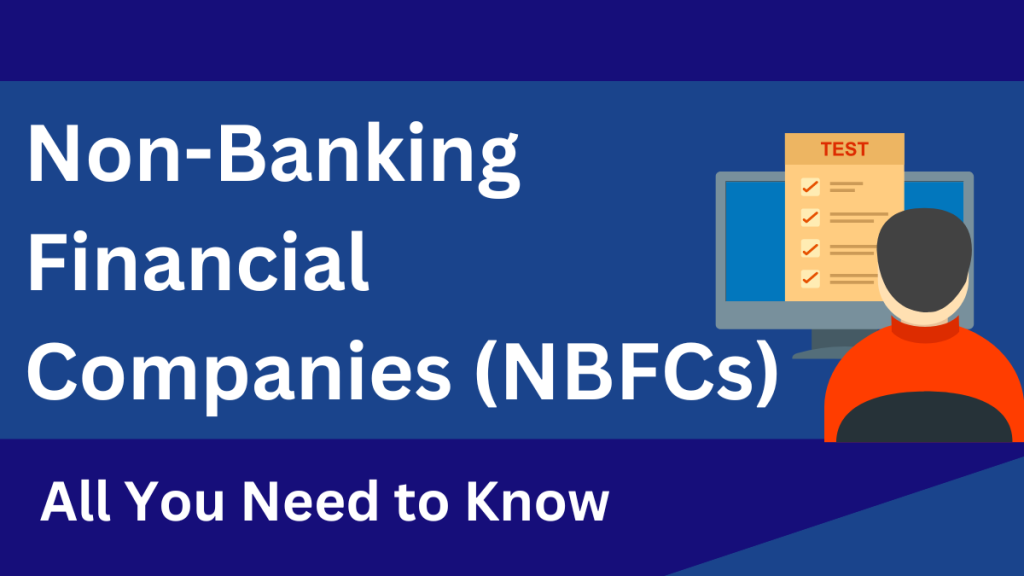The financial landscape of any country is not limited to banks alone. While banks play a significant role in ensuring economic stability and financial inclusion, other institutions contribute just as much to the financial ecosystem. One of the key players in this domain are Non-Banking Financial Companies (NBFCs). Over the years, NBFCs have grown to be a important part of the Indian financial system, providing a wide array of financial services and reaching out to a larger customer base.
In this blog, we will explore everything you need to know about Non-Banking Financial Companies (NBFCs), their importance, their role in the economy, and much more.

What Is Non-Banking Financial Companies (NBFCs)?
Non-Banking Financial Companies (NBFCs) are financial institutions that offer banking-like services but do not hold a banking license. In essence, NBFCs provide financial products like loans, asset management, insurance, and investment services without accepting traditional demand deposits (such as savings or current accounts) from the public. This means that they are not permitted to issue cheques or facilitate withdrawals, unlike banks.
NBFCs are regulated by the Reserve Bank of India (RBI) under the Reserve Bank of India Act, 1934, and the specific laws governing NBFCs fall under Chapter III B of this Act. Although they do not have full banking privileges, they still play a significant role in the financial services sector.
Key Characteristics of Non-Banking Financial Companies
- No Deposit Holding: Unlike banks, NBFCs are not permitted to accept demand deposits.
- Credit Intermediation: They offer various forms of credit, including personal loans, vehicle financing, and business loans.
- Regulatory Framework: While banks are regulated under the Banking Regulation Act, NBFCs are primarily governed by the RBI’s regulations specific to them.
- No Payment Systems: NBFCs do not engage in payment or settlement systems.
- Limited Banking Services: Although they provide financial services, NBFCs cannot issue cheques or allow cash withdrawals.
Evolution of NBFCs in India
The concept of Non-Banking Financial Companies in India is not new. NBFCs have existed for decades, but they gained substantial prominence in the post-liberalization era of the 1990s. Their growth has been impressive due to their ability to cater to the financial needs of sectors that traditional banks often overlook.
Initially, NBFCs were primarily involved in asset finance and leasing services. However, over time, they have diversified their product portfolio to include loans, insurance, mutual funds, and even microfinance. This evolution has positioned them as one of the fastest-growing sectors within the financial services industry in India.
NBFCs have emerged as a lifeline for individuals and businesses that do not have access to formal banking services, particularly in rural and semi-urban areas. They have also played a important role in expanding financial inclusion in the country.
Types of Non-Banking Financial Companies (NBFCs)
Non-Banking Financial Companies (NBFCs) are classified by the RBI into categories based on their functions, including asset finance companies, investment companies, loan companies, infrastructure finance companies, and microfinance institutions. Each type of NBFC caters to specific financial needs, playing a crucial role in India’s diverse financial ecosystem.
Asset Finance Companies (AFCs)
These are NBFCs that are primarily engaged in financing physical assets such as automobiles, tractors, and other industrial machinery. They specialize in providing loans for purchasing vehicles, equipment, and heavy machinery.
Loan Companies (LCs)
Loan companies focus on providing different types of loans that can range from personal loans, business loans, and loans against property to consumer credit.
Investment Companies (ICs)
Investment companies are Non-Banking Financial Companies that deal primarily with investments in securities and financial instruments like stocks and bonds.
Infrastructure Finance Companies (IFCs)
IFCs focus on financing infrastructure projects such as highways, airports, power plants, and urban development initiatives.
Microfinance Institutions (MFIs)
Microfinance institutions offer small loans to low-income individuals and self-help groups. They play a significant role in promoting financial inclusion by providing access to credit in rural and underdeveloped areas.
Housing Finance Companies (HFCs)
HFCs specialize in offering home loans, mortgages, and other housing-related financial products. These NBFCs focus on the real estate sector and facilitate home ownership for individuals.
NBFC-Factor
These are Non-Banking Financial Companies that specialize in factoring, which means they purchase the receivables of companies and provide immediate liquidity.
Importance of NBFCs in the Indian Economy
NBFCs are an essential component of India’s financial ecosystem. Their importance cannot be overstated, as they fill the gaps left by traditional banking institutions. Below are some of the key reasons why Non-Banking Financial Companies are vital:
Financial Inclusion
One of the most important contributions of Non-Banking Financial Companies is their role in promoting financial inclusion. Many rural and semi-urban areas in India lack access to formal banking services. NBFCs step in to provide financial products to these underserved markets, thereby enhancing economic participation.
Niche Market Focus
Banks often target large and medium-sized enterprises, while NBFCs tend to focus on niche markets such as small and medium enterprises (SMEs), individuals with limited credit history, and those seeking specialized financial services like vehicle finance or microloans. This specialization allows NBFCs to serve segments of the market that may not be attractive to larger banks.
Flexibility and Innovation
NBFCs have a higher degree of flexibility compared to traditional banks. This flexibility allows them to innovate and introduce new financial products that cater to evolving customer needs. For instance, many NBFCs have embraced fintech, leveraging technology to offer seamless digital lending solutions.
Complementing Banks
Rather than competing directly with banks, NBFCs complement them by offering services in areas where banks may not have a strong presence. They work in tandem with banks to enhance the overall financial landscape of the country.
Catalyst for Economic Growth
The availability of credit is significant for economic growth, and Non-Banking Financial Companies play a significant role in meeting the credit demands of various sectors, including agriculture, manufacturing, real estate, and infrastructure. By providing timely and accessible credit, NBFCs act as a catalyst for economic development.
Key Differences Between NBFCs and Banks
While both NBFCs and banks are financial institutions, they operate under different regulatory frameworks and serve somewhat distinct purposes. Here are some of the key differences between Non-Banking Financial Companies and banks:
- Deposit Acceptance: Unlike banks, NBFCs cannot accept demand deposits from the public.
- Regulation: Banks are governed by the Banking Regulation Act, while NBFCs fall under the purview of the RBI’s specific regulations for NBFCs.
- Payment Systems: NBFCs are not part of the payment and settlement system, meaning they cannot issue cheques or facilitate withdrawals.
- Statutory Reserve Requirements: While banks are required to maintain cash reserve ratios (CRR) and statutory liquidity ratios (SLR), NBFCs do not have such requirements.
- Government Guarantees: Deposits made in banks are guaranteed up to a certain limit by the Deposit Insurance and Credit Guarantee Corporation (DICGC), whereas NBFC deposits do not have such backing.
Role of Technology in NBFC Growth
The advent of technology, especially fintech, has revolutionized the way Non-Banking Financial Companies operate. Digital lending platforms, online customer acquisition, and data-driven credit assessments are some of the innovations that have helped NBFCs scale their operations and reach more customers efficiently.
Technology has enabled NBFCs to offer quick and hassle-free financial products, particularly in the lending space. Many NBFCs now leverage AI and machine learning to evaluate creditworthiness, making it easier to lend to those with limited credit histories. This digital transformation has not only boosted customer satisfaction but has also helped NBFCs reduce their operational costs.
Challenges Faced by NBFCs
Despite their significant contributions, Non-Banking Financial Companies (NBFCs) face challenges like liquidity constraints, regulatory hurdles, rising non-performing assets (NPAs), and stiff competition from traditional banks and fintech companies. These issues impact their ability to grow and provide seamless services, making it difficult for NBFCs to sustain long-term operations:
- Regulatory Changes: The regulatory framework for NBFCs is ever evolving, and adhering to new rules and compliance measures can be challenging.
- Liquidity Crises: Several NBFCs have faced liquidity issues in the past, especially in the wake of events like the collapse of IL&FS, which triggered a financial crisis within the sector.
- Credit Risk: Since many NBFCs serve customers who may not have strong credit histories, they are often exposed to higher levels of credit risk.
Future of Non-Banking Financial Companies (NBFCs)
The future of Non-Banking Financial Companies (NBFCs) in India looks bright, with several factors indicating continued growth and expansion. As the demand for financial services increases in underserved sectors, NBFCs will continue to fill the gaps left by traditional banks. Additionally, the rapid advancement in financial technology (fintech) is helping Non-Banking Financial Companies provide better, faster, and more efficient services to their customers.
The growing adoption of digital platforms by NBFCs is a significant trend that will shape their future. With more people turning to digital financial services, Non-Banking Financial Companies have begun to streamline their processes, offering faster loan approvals and disbursals through mobile applications and websites. Digital lending has become a cornerstone for many NBFCs, as it allows them to reach out to a broader audience while reducing costs.
Moreover, NBFCs are likely to see increased collaboration with fintech companies to create innovative financial solutions. By integrating advanced technologies such as artificial intelligence (AI) and blockchain, Non-Banking Financial Companies can further improve their services, reduce fraud, and offer customized solutions to customers based on their specific financial needs.
Government Support and Regulatory Changes
The Indian government and the Reserve Bank of India (RBI) have recognized the importance of Non-Banking Financial Companies in the financial ecosystem. To ensure the stability and growth of NBFCs, the government has introduced various regulatory measures. These regulations aim to strengthen the financial health of NBFCs and protect them from liquidity crises, such as the ones experienced in the past.
For example, the RBI has introduced stricter guidelines regarding asset quality, capital requirements, and corporate governance for Non-Banking Financial Companies. These changes ensure that NBFCs remain financially sound and continue to operate with transparency and accountability. Additionally, the introduction of liquidity coverage ratio (LCR) requirements ensures that NBFCs maintain sufficient liquidity to meet their short-term obligations.
The government has also emphasized the importance of NBFCs in achieving financial inclusion. By encouraging Non-Banking Financial Companies to expand their operations in rural and semi-urban areas, the government hopes to bring more individuals and small businesses into the formal financial fold. This support is likely to drive the expansion of NBFCs into new territories, further increasing their customer base.
Opportunities for Growth
Several opportunities exist for Non-Banking Financial Companies (NBFCs) to continue their growth trajectory. One of the most significant opportunities lies in the untapped potential of India’s rural markets. Many rural areas in India still lack access to formal financial services, and NBFCs are well-positioned to cater to these regions with their specialized products.
Furthermore, with the increasing importance of environmental, social, and governance (ESG) criteria in financial services, NBFCs can tap into sustainable financing. Many Non-Banking Financial Companies are now offering green finance solutions that fund projects in renewable energy, electric vehicles, and other sustainable industries.
Final Thoughts
In conclusion, Non-Banking Financial Companies (NBFCs) are a vital part of India’s financial system. They provide much-needed services to segments of the population that banks may not reach, thereby contributing to financial inclusion and overall economic growth. By offering a wide range of financial products, from loans to investments, NBFCs are filling significant gaps in the country’s financial ecosystem. With the advent of technology and the growing demand for alternative financial solutions, NBFCs are poised for significant growth in the coming years, despite the challenges they may face.
As NBFCs continue to evolve and innovate, they will play an even more important role in shaping the future of India’s financial landscape. Whether you are an individual looking for financial products or a business seeking credit, Non-Banking Financial Companies can offer solutions tailored to your specific needs.
If you’re preparing for government exams like SSC CGL, SSC CHSL, IBPS PO, SBI Clerk, or RBI Grade B, ixamBee is your one-stop solution for success. Our comprehensive resources include government exam mock tests, government exam PYPs (previous year papers), and expertly curated study materials designed to help you crack any exam. With ixamBee’s extensive offerings, you’ll get the edge you need to ace these competitive exams. Stay ahead of the competition with our updated courses for upcoming government jobs like LIC AAO and NIACL AO, ensuring you’re always prepared.
At ixamBee, we specialize in providing comprehensive online courses for government exams and online courses for government jobs. Our expertly designed courses for government jobs cater to a wide range of upcoming government exams. Whether you’re preparing for specific courses for government exams or seeking general guidance, ixamBee offers the resources like Beepedia previous year papers, SSC CGL, SSC CHSL, SSC MTS and other mock tests to succeed in exams like RBI Grade B, SEBI Grade A, NABARD Grade A, RRB NTPC, SSC MTS, NIACL Assistant, and more.
Also Read:
Cracking NABARD Grade A Exam: Tips and Preparation Strategies
How to Prepare for SEBI Grade A 2025 Exam
Top Government Job Opportunities After BTech in 2024: Your Ultimate Guide to a Rewarding Career












